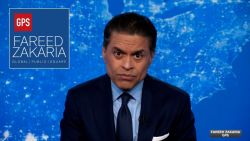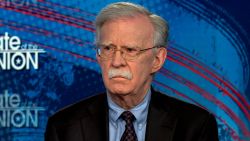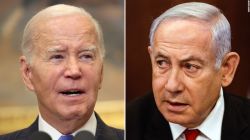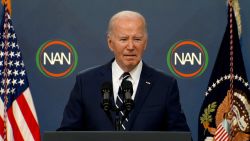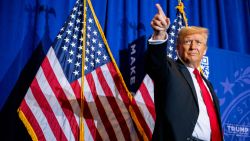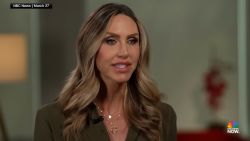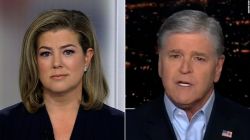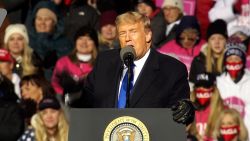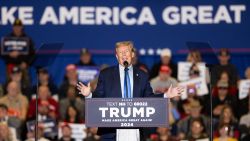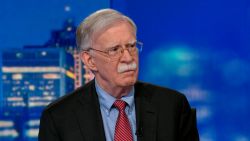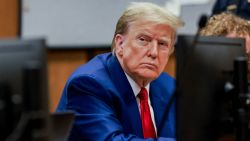Watch Rene Marsh’s exclusive report on TSA security tonight at 5 p.m. ET on CNN’s “The Situation Room” with Wolf Blitzer.
A whistleblower with the Transportation Security Administration is sounding the alarm about loosened security at US airports, charging that top TSA officials have prioritized speed over security by reducing the sensitivity of metal detectors, disabling technology on some X-ray machines, issuing orders to keep the baggage conveyor belts moving in certain circumstances and ordering policy changes that result in fewer pat-downs.
Jay Brainard, the highest-ranking TSA official in Kansas, has notified the highest reaches of the TSA as well as outside federal regulatory bodies about the matter, but says little is being done. He believes the relaxed security rules that have occurred over the past couple of years are putting US passengers at risk.
“My biggest fear is having something happen that costs American lives, and I didn’t step up and put a stop to it,” Brainard told CNN this week. “It’s not a question of if, it’s a question of when. We are long overdue for an attack.”
In a prior complaint, he spurred the TSA into action by revealing that officers hadn’t been adequately tested for colorblindness. This poses a security problem because X-ray operators need to be able to differentiate between colors to spot potential explosives in bags. As a result of Brainard’s 2017 complaint, the TSA is re-testing its employees for “color vision,” but the process isn’t slated for completion until the end of 2020.
Brainard’s complaints come as US airports are experiencing record-breaking numbers of travelers. On December 1, the TSA screened more than 2.8 million passengers, making it the busiest day in the agency’s history, according to Airlines for America, an industry trade organization and lobbying group for major US airlines. TSA estimates that 42 million passengers will stream through the checkpoints at US airports between December 19 and January 5 – an increase of 3.9% from the same period a year ago, the organization said in a press release.
Meanwhile, officials at the TSA – which was founded in response to the terrorist attacks of 9/11 – acknowledge that US airports remain a target.
David Pekoske, the head of the TSA, told CNN in response to the whistleblower’s allegations that his agency is not putting wait times ahead of security.
“If you go back and you look at my testimony before the Senate Commerce Committee – my confirmation – so back in June of 2017, one of the first things I said is that security is the most important thing for TSA,” he said. “And that throughput is secondary to our process.”
TSA reduced wait time by relaxing security measures, whistleblower says
Wait times have been a fraught topic in the world of commercial aviation since 2016, when they became a national headache, prompting some lawmakers to call for the resignation of then-TSA head Peter V. Neffenger. Since then, they have improved significantly, according to a recent L.A. Times analysis. While the passenger count at the nation’s 444 airports has surged by 15% in three years, wait times across the board barely budged in that time – rising by less than half a minute.
The TSA attributed the improvements to several factors, including a beefed-up staff of screeners, improved communications with airlines and airports, and a tripling in the number of passengers – to 9 million –who pay to use the expedited lines known as PreCheck lanes since 2016.
But Brainard believes the TSA has also reduced wait times by inappropriately relaxing security measures.
Brainard said he has taken his complaints about the metal detectors, X-rays and pat-down procedures to the US Office of Special Counsel.
The special counsel saw merit in his complaint, and ordered the Department of Homeland Security, which oversees the TSA, to launch an internal audit in July 2018, according to documents obtained by CNN. But Brainard says it appears to be in no hurry: The review’s initial 60-day deadline has been repeatedly extended.
Brainard received a response from an OSC attorney in July saying part of the DHS investigation was complete, but that it wouldn’t be ready for review until completion of the full report in September. Brainard says the report has yet to be released.
“Stonewalling an investigation for more than 500 days is not acting with a sense of urgency and purpose,” he told CNN.
Reached by CNN this week about the status of the investigation, the OSC declined to comment.
Among Brainard’s specific claims:
- Walkthrough metal detectors at all US airports have been switched to a reduced-sensitivity setting – below levels they were at in the years following 9/11 – which Brainard says could potentially enable bomb components, 3-D printed weapons and other suspicious items to pass through. Brainard says sensitivity levels have not been altered with the body scanners.
- The TSA has instructed officers to keep the X-ray conveyor belts moving in the expedited PreCheck lines, hampering their ability to zero in on questionable items in bags.
- Automated settings on X-ray machines on PreCheck conveyor belts for luggage that flag suspicious items for employees operating the machines have been turned off, removing a computerized tool to help them scan for threats.
- The TSA before late 2017 failed to adequately screen TSA officers for colorblindness, which is a disqualifier for employment in the agency because officers need to be able to differentiate between colors to spot potential explosives when using the X-ray machines.
- The TSA has ordered that officers allow some passengers with medical devices, such as casts or prosthetics, to do a self-pat down when they set off the alarm. The decision was made out of sensitivity to people with medical conditions. Although, they are allowed to do a self-pat down they will undergo an explosive detection test and have hand swab to check for evidence of explosives.
- The TSA allows unvetted non-PreCheck passengers into the PreCheck lanes in order to speed up the lines. The agency told CNN it is in the process of phasing out that practice. While they have stopped allowing non-PreCheck travelers in PreCheck lanes at smaller airports the practice remains in effect at larger US airports where the vast majority of aviation traffic passes through. TSA’s administrator told CNN the non-PreCheck passengers who do get PreCheck are not just ” a random person” and that the agency uses “a methodology that I can’t discuss.”
Peter Goelz, the former managing director of the National Transportation Safety Board and an aviation analyst for CNN, said taking down an aircraft or causing a loss of life on an aircraft is the top priority of terrorists.
“That’s the crown jewel,” he said. “And if we’re turning down sensitivity to increase speed, we are putting people at risk. And particularly the flight crews in the cabin. … They’re the last line of defense. Boy, if – when they find out that this is taking place, there’s going to be an outcry from them.”
TSA chief: Level of screening based on risks passengers pose
In one example, Brainard cited how, on the X-ray machines for the baggage conveyor belts for PreCheck lanes, the TSA has turned off an automated setting – called “bounding boxes” – that flags suspicious items.
“Put simply, when the item comes through, a box would come around and surround the item and say ‘hey, stop and take a look at this,’” he told CNN.
This, he said, means the successful prevention of a bad actor carrying an explosive or dangerous item through a PreCheck lane rests solely with the TSA officer operating the machine, without help provided by automation.
Pekoske acknowledged that passengers in “trusted traveler” programs such as PreCheck are subject to less screening scrutiny than standard passengers, but says that is for good reason.
“TSA looks to provide the level of screening based on the risks that a passenger presents,” he said. “Because those individuals registered into a program and gave us their background information and we did a full background check on them, then we can modify somewhat the security procedures that we use.”
The TSA has been dinged for security lapses in recent years. In 2015, agents with Department of Homeland Security posing as passengers snuck fake explosives through the security lines of several of the nation’s busiest airports. During the test, TSA officers missed 67 of the 70 fake weapons that went through the checks – a failure rate of 95%. As a result, the TSA’s head administrator, Melvin Carraway, was reassigned to a program that coordinates with local law enforcement agencies under the Department of Homeland Security. Brainard said these security vulnerabilities began before Carraway took over as head of the agency.
Two years later, Department of Homeland Security auditors found the TSA was still performing poorly in detecting dangerous items at checkpoints.
Brainard, who is in charge of a medium-sized airport, said while he began noticing the shift in priority in 2012, it ramped up in 2017, when the TSA’s presidentially appointed head, David Pekoske, took the reins.
“In the last two years, the focus of sacrificing security over wait times has increased tremendously,” Brainard said. “That’s the reason I have come forward. It is happening so fast that it’s difficult to keep up with the notes.”
Brainard said he has emailed his concerns to Pekoske, who, Brainard says, has acknowledged the issues but has yet to fix them.
In a 2018 hearing on Capitol Hill, Pekoske said it is the job of TSA management – not officers – to worry about wait times.
“It makes no sense to have a lot of people moving through a security line very quickly with bad security,” he told a lawmaker who asked whether wait times are more important than security.
A 17-year veteran with the agency, Brainard – who has retained a whistleblower attorney – said he is prepared for blowback.
“I fully expect that the first discussion they’re going to have is how they can fire me,” he said.
In his annual performance reviews, Brainard said he has been marked for “achieves excellence” every year of his tenure. His latest review, completed in October and obtained by CNN, is marked with a handwritten comment: “Great year, Jay – thank you!”
In recent years, the TSA has faced allegations of retaliating against whistleblowers – to such an extent that Congress passed additional whistleblower protections for employees at the agency in 2012. But since then, more employees have come forward with retaliation accusations.
Brainard also alleges that the TSA puts undue pressure on directors to clamp down on wait times. In the past couple of years, he said, the TSA has sent out thousands of “wait alert” emails to all federal directors in the system to call out any airport that is experiencing extended wait times.
“You could have a 30-minute wait time at an airport that processes 60,000 passengers a day, and they treat it like it’s a national emergency,” he said, noting that no alerts have yet singled out his coverage area. “It’s an intimidation tool.”
When asked about Brainard’s complaints, Pekoske said that while whistleblowers “provide a very valuable service … it’s our responsibility to fully investigate those concerns to see if they represent a valid – in TSA’s perspective – a valid security risk or not.”
“We have not completed our assessment” of Brainard’s allegations, he added. “But I can tell you that I am very confident in the process that we use in our trusted traveler lanes is the appropriate level of security for those passengers.”
Whistleblower: ‘Blended lanes’ are problematic
Congress has already tried to crack down on some of the TSA’s moves to reduce wait times. Last year it passed a bill that sought to prohibit the TSA from putting standard passengers in expedited, so-called PreCheck lines.
The “PreCheck is PreCheck Act of 2018” cleared the House but has not passed in the Senate.
Brainard said the TSA has similarly rolled out a new optional policy allowing airport security to merge the standard and PreCheck lines into one. This, he said, creates a confusing situation for security officers, because the PreCheck passengers require less screening than standard passengers – meaning the officers have to mentally keep track of which standards to apply on a case-by-case basis in real time, as passengers are streaming through. He has initiated a separate US Office of Special Counsel investigation about these so-called “blended lanes.” The OSC ordered the Department of Homeland Security to launch the probe in November.
Brainard also raised the issue of colorblindness to the Department of Homeland Security’s Office of Inspector General and the US Office of Special Counsel.
In December 2017, several months after Brainard’s complaint, the TSA mandated that all new hires be subjected to more rigorous vision testing. But the agency won’t finish re-testing people already on staff until the end of 2020, another year in which that not everybody working on the front lines for TSA will have been tested to ensure they can differentiate between colors and thus spot explosives in bags on X-ray machines.
One of the most recent policy changes spells out what to do if a PreCheck passenger wearing a prosthetic or other medical device like a cast or sling sets off a walkthrough metal detector, Brainard said. Those passengers will have their hands swabbed for explosives but will pat themselves down. Brainard believes leaving the pat-down to the passenger makes it easier for a prohibited item to be concealed and smuggled onto a passenger plane.
“It doesn’t make any sense to … introduce a secondary barrier in the effectiveness to locate explosives,” Brainard said. “Especially when you (already) have such an abysmal testing rate.”
‘The system can take no more risk’
Brainard said the TSA officers are not to blame for the high failure rate in the 2015 test by the Department of Homeland Security’s so-called “Red Teams” of undercover agents, or for the more recent policy changes that he says prioritize speed over safety.
“The officers are doing precisely what senior leadership tells them to do,” he said. “And they get scapegoated every time there’s a red team report that comes out about our abysmal testing results.”
He believes airports are less safe than they were five years ago due to the “diluted” security procedures – a trend that he says has accelerated in the last two years.
“They have de-sensitized the machines, they have turned off security features,” he said. “You don’t do those things with a 95% failure rate on your covert detection. All (they) were doing is introducing more risk into the system, when the system can take no more risk.”
Goelz warned that vulnerabilities in the TSA’s security system can lead to catastrophe.
“There is no question … if all of the holes line up, you’re going to have a crisis,” he said. “And with these kinds of failure rates, it’s simply a matter of time.”
This story has been updated to include Brainard’s statement about when the security vulnerabilities began.




